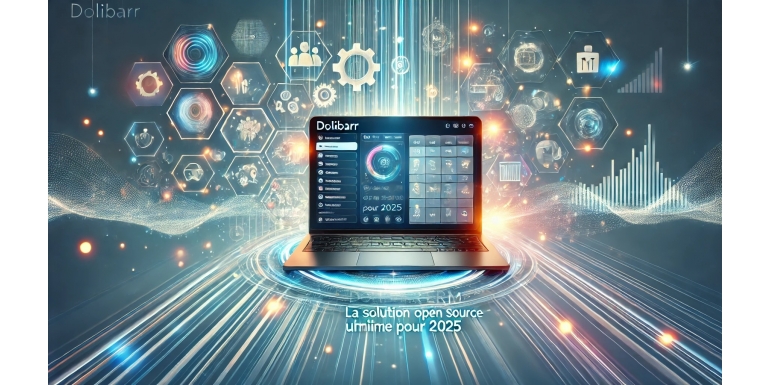
In 2025, the ERP (Enterprise Resource Planning) software sector is evolving at an unprecedented pace. Digitalization and automation have become essential, both for SMEs and larger enterprises. In this environment, Dolibarr, an open-source ERP/CRM, stands out as a modern, high-performance solution that is also adaptable to a variety of needs. In this article, we will explore why Dolibarr is shaping up to be the ultimate solution in 2025, and how it meets the latest market demands.
1. The Current Market Challenges in 2025
1.1. The Need for Flexibility
Companies of all sizes must constantly adapt to a competitive and regulatory environment that is in constant flux. They need scalable solutions capable of adjusting quickly to market transformations. A rigid or overly specialized ERP can quickly become an obstacle to growth. Thanks to its modularity, Dolibarr is particularly flexible, suitable for many different contexts (SMEs, e-commerce, freelancers, associations, etc.).
1.2. Collaboration at the Heart of Transformation
In 2025, remote work and real-time collaboration are the norm. Teams need intuitive tools for coordinating tasks, sharing documents, and tracking project progress. Dolibarr provides a range of collaborative features (project templates, resource management, Kanban views, etc.) while streamlining interaction among different departments or units.
1.3. Data and AI as the Drivers of Competitiveness
The growing importance of data and artificial intelligence makes it crucial to use an ERP/CRM that handles and analyzes data effectively. Dolibarr already offers various reporting and visualization functions; and because of its open-source architecture, it can be expanded with AI modules or advanced BI connectors, enabling organizations to make strategic, data-driven decisions.
2. Why Dolibarr Is the Ultimate Solution
2.1. An Open Source Model Ensuring Scalability
Dolibarr’s open-source nature means its source code is publicly accessible, so it can be improved or audited by the community. This means:
- Constant improvements: the international community continuously develops and fixes it.
- Lower costs: the absence of expensive licensing fees typical of proprietary software.
- Greater transparency: users know exactly how the software operates.
2.2. Modularity to Suit Everyone
Dolibarr provides a broad set of modules (CRM, Invoicing, Project Management, HR, Inventory, etc.), each of which can be enabled or disabled based on your needs. For instance, a small nonprofit might only activate membership and dues management, whereas a growing SME might use CRM, invoicing, logistics, etc., all without overburdening the interface or paying for unnecessary features.
2.3. Innovations Aligned with Current Trends
With each new version, Dolibarr integrates increasingly advanced features:
- Cloud connectors and a REST API that simplify integration with other services (e-commerce, external accounting solutions, BI).
- Advanced automation: You can configure triggers to automate document creation, email dispatch, updating project statuses, etc.
- Enhanced security: support for SSL/TLS encryption, granular access management modules, audit logs, etc.
3. Concrete Benefits for Companies
3.1. Greater Control and Visibility
Centralizing information (clients, stock, invoices, projects) in one tool improves visibility for all staff, who can then plan their actions more effectively. Company leaders have access to dashboards that allow them to detect quickly any drop in sales or overdue payments.
3.2. Cost and Time Savings
With its open-source model, Dolibarr avoids licensing fees often associated with proprietary ERP. Moreover, by automating certain tasks (invoicing, follow-ups, stock monitoring), the tool reduces manual workload and limits errors.
3.3. Enhanced Customer Experience
Dolibarr’s CRM function allows personalized tracking of prospects and customers: you can monitor interactions, sales history, and even set up automatic follow-ups. Sales teams access key information in real time, improving their responsiveness and customer satisfaction.
3.4. Long-Term Scalability
By 2025, the long-term viability of an ERP/CRM is crucial. Supported by its community and modular design, Dolibarr can grow alongside a company (adding modules, moving to a more robust infrastructure, etc.) without a major software overhaul.
4. Implementation and Practical Tips
4.1. Assess Your Needs
Before deploying the software, we recommend mapping your internal processes (sales, production, accounting, logistics) to identify the Dolibarr modules you should enable. This avoids functional overload and clarifies how the tool will be structured.
4.2. Choose the Right Infrastructure
Dolibarr can be:
- Hosted locally on an internal server or a NAS, ideal for organizations with dedicated IT personnel.
- Hosted in the cloud (VPS, PaaS solutions specifically for Dolibarr), reducing hardware maintenance constraints.
4.3. Train and Involve Your Teams
Training is key to widespread adoption: it’s crucial to spend time explaining workflows, the modular concept, and the interface layout. Likewise, involving staff in the evaluation and configuration stages ensures they take ownership of the software.
4.4. Customize and Secure
Each company can customize Dolibarr to suit their requirements:
- Interface adaptation (fields, themes, labels).
- Automation using scripts or triggers.
- Security (HTTPS, multi-factor authentication, scheduled backups).
Conclusion
In 2025, digital transformation is a strategic priority for organizations everywhere. Thanks to its open-source DNA, modular approach, and a devoted international community, Dolibarr meets the demands of a constantly evolving market. Combining flexibility, cost savings, and high growth potential, Dolibarr stands out as the ultimate ERP/CRM solution for thriving in this new era of digitalization.
Whether you’re a start-up, an SME, or a large enterprise, Dolibarr allows a gradual implementation, adapting as you grow and integrating with many external services. These are just some of the reasons why Dolibarr remains a top open-source solution in 2025—and why it might be time for you to benefit from this dynamic tool, too!
